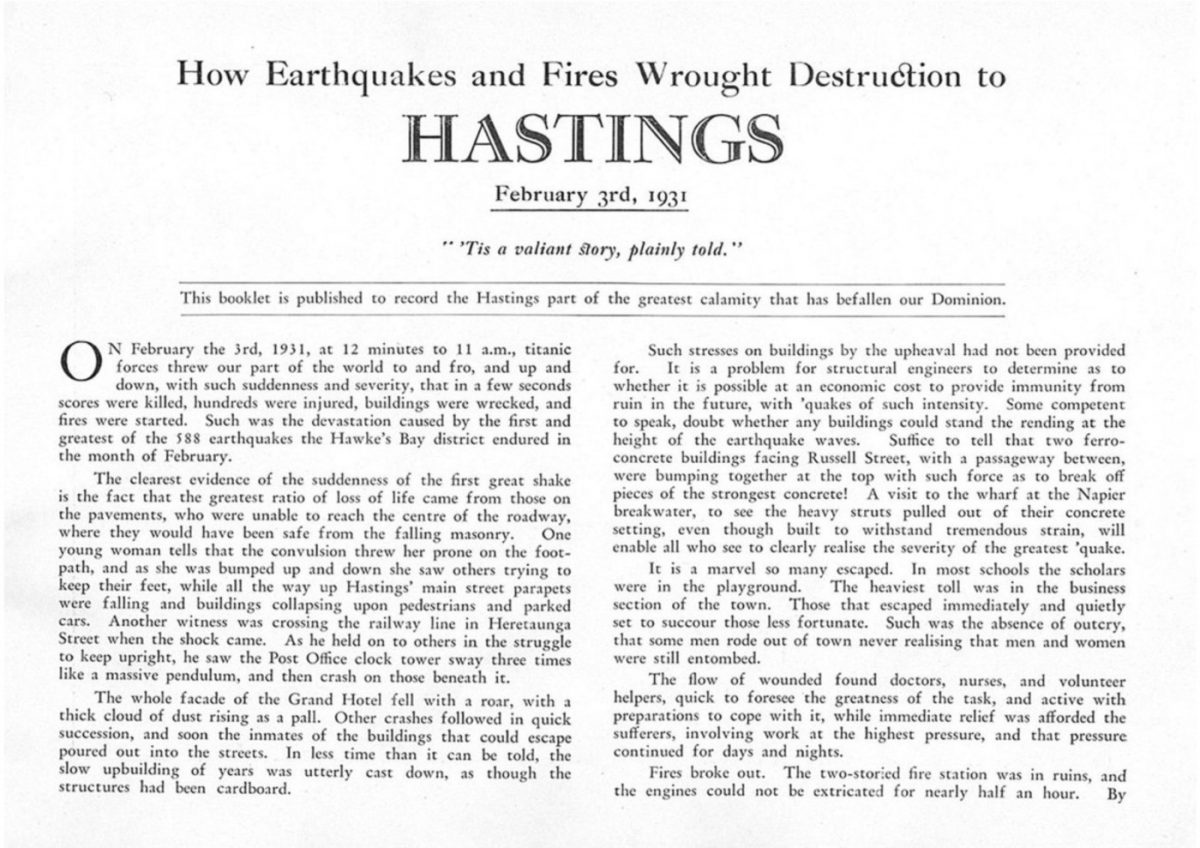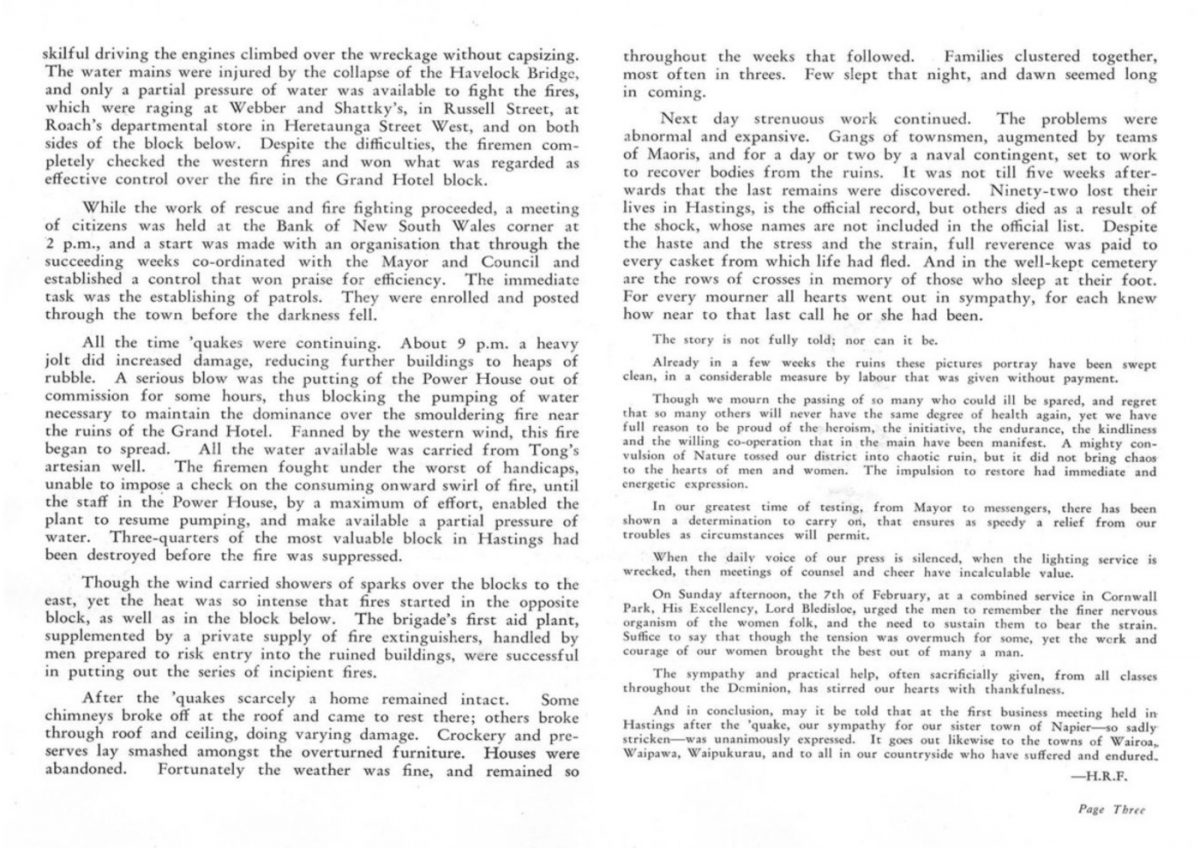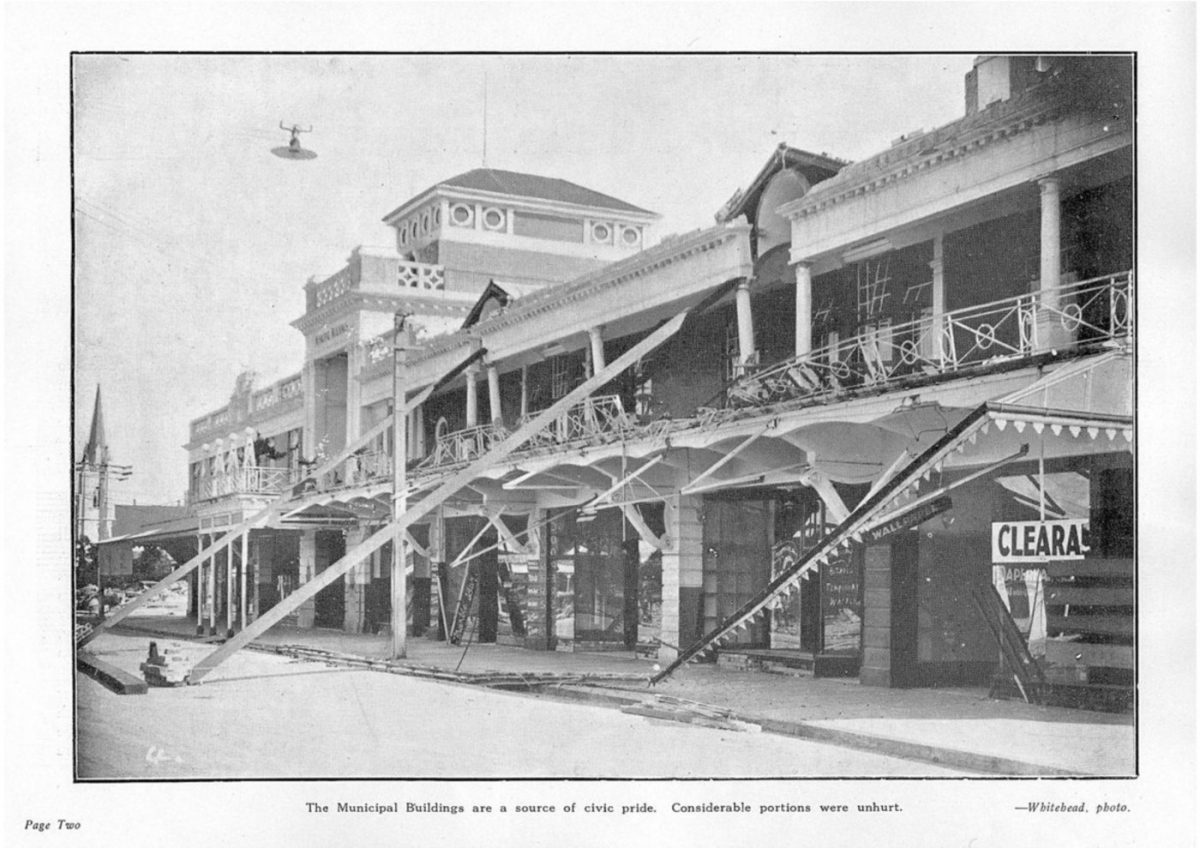- Home
- Collections
- Books
- How New Zealand's Greatest Disaster Shattered Hastings - Earthquakes and Fires
How New Zealand’s Greatest Disaster Shattered Hastings – Earthquakes and Fires
How Earthquakes and Fires Wrought Destruction to
HASTINGS
February 3rd, 1931
“’Tis a valiant story plainly told.”
This booklet is published to record the Hastings part of the greatest calamity that has befallen our Dominion.
ON February 3rd, 1931, at 12 minutes to 11.am., titanic forces threw our part of the world to and fro, and up and down, with such suddenness and severity, that in a few seconds scores were killed, hundreds were injured, buildings were wrecked, and fires were started. Such was the devastation caused by the first and greatest of the 588 earthquakes the Hawke’s Bay district endured in the month of February.
The clearest evidence of the suddenness of the first great shake is the fact that the greatest ratio of loss of life came from those on the pavements, who were unable to reach the centre of the roadway, where they would have been safe from the falling masonry. One young woman tells that the convulsion threw her prone on the foot-path, and she was bumped up and down she saw others trying to keep their feet, while all the way up Hastings’ main street parapets were falling and buildings collapsing upon pedestrians and parked cars. Another witness was crossing the railway line in Heretaunga Street when the shock came. As he held on to others in the struggle to keep upright, he saw the Post Office clock tower sway three times like a massive pendulum, and then crash on those beneath it.
The whole facade of the Grand Hotel fell with a roar, with a thick cloud of dust rising as a pall. Other crashes followed in quick succession, and soon inmates of the buildings that could escape poured out into the streets. In less time than it can be told, the slow upbuilding of years was utterly cast down as though the structures had been cardboard.
Such stresses on buildings by the upheaval had not been provided for. It is a problem for structural engineers to determine as to whether it is possible at an economic cost to provide immunity from ruin in the future, with ‘quakes of such intensity. Some competent to speak, doubt whether any buildings could stand the rending at the height of the earthquake waves. Suffice to tell that two ferro-concrete buildings facing Russell Street, with a passageway between, were bumping together at the top with such force as to break off pieces of the strongest concrete! A visit to the wharf at the Napier breakwater to see the heavy struts pulled out of their concrete setting, even though built to withstand tremendous strain will enable all who see to clearly realise the severity of the greatest ‘quake.
It is a marvel so many escaped. In most schools the scholars were in the playground. The heaviest toll was in the business section of the town. Those that escaped immediately and quietly set to succour those less fortunate. Such was the absence of outcry, that some men rode out of town never realising that men and women were still entombed.
The flow of wounded found doctors, nurses and volunteer helpers quick to foresee the greatness of the task, and active with preparations to cope with it, while immediate relief was afforded the sufferers, involving work at the highest pressure, and that pressure continued for days and nights.
Fires broke out. The two-storied fire station was in ruins, and the engines could not be extricated for nearly half an hour. By

Page Three
skillful driving the engines climbed over the wreckage without capsizing. The water mains were injured by the collapse of Havelock Bridge, and only a partial pressure of water was available to fight the fires, which were raging at Webber and Shattky’s in Russell Street, at Roach’s departmental store in Heretaunga Street West, an on both sides of the block below. Despite the difficulties, the firemen completely checked the western fires and won what was regarded as effective control over the fire in the Grand Hotel block.
While the work of rescue and fire fighting proceeded, a meeting of citizens was held at the Bank of New South Wales corner at 2 p.m., and a start was made with an organisation that through the succeeding weeks co-ordinated with the Mayor and Council and established a control that won praise for efficiency. The immediate task was the establishing of patrols. They were enrolled and posted through the town before the darkness fell.
All the time ‘quakes were continuing. About 9 p.m. a heavy jolt did increased damage, reducing further buildings to heaps of rubble. A serious blow was putting of the Power House out of commission for some hours, thus blocking the pumping of water necessary to maintain the dominance over the smouldering fire near the ruins of the Grand Hotel. Fanned by the western wind, this fire began to spread. All the water available was carried from Tong’s artesian well. The firemen fought under the worst of handicaps, unable to impose a check on the consuming onward swirl of fire, until the staff in the Power House, by a maximum of effort, enabled the plant to resume pumping, and make available a partial pressure of water. Three quarters of the most valuable block in Hastings had been destroyed before the fire was suppressed.
Though the wind carried showers of sparks over the blocks to the east, yet the heat was so intense that fires started in the opposite block, as well as in the block below. The brigade’s first aid plant supplemented by a private supply of fire extinguishers, handled by men prepared to risk entry into the ruined buildings, were successful in putting out the series of incipient fires.
After the ‘quakes scarcely a home remained intact. Some chimneys broke off at the roof and came to rest there; others broke through roof and ceiling, doing varying damage. Crockery and preserves lay smashed amongst the overturned furniture. Houses were abandoned. Fortunately the weather was fine, and remained so throughout the weeks that followed. Families clustered together, most often in threes. Few slept that night, and dawn seemed long in coming.
Next day strenuous work continued. The problems were abnormal and expansive. Gangs of townsmen, augmented by teams of Maoris, and for a day or two by a naval contingent, set to work to recover bodies from the ruins. It was not till five weeks afterwards that the last remains were discovered. Ninety-two lost their lives in Hastings, is the official record, but others died as a result of the shock, whose names are not included in the official list. Despite the haste and the stress and the strain, full reverence was paid to every casket from which life had fled. And in the well-kept cemetery are the rows of crosses in memory of those who sleep at their foot. For every mourner all hearts went out in sympathy, for each knew how near to that last call he or she had been.
This story is not fully told; nor can it be.
Already in a few weeks the ruins these pictures portray have been swept clean, in a considerable measure by labour that was given without payment.
Though we mourn the passing of so many who could ill be spared, and regret that so many others will never have the same degree of health again, yet we have full reason to be proud of the heroism, the initiative, the endurance, the kindliness and the willing co-operation that in the main have been manifest. A mighty convulsion of Nature tossed our district into chaotic ruin, but it did not bring chaos to the hearts of men and women. The impulsion to restore had immediate and energetic expression.
In our greatest time of testing, from Mayor to messengers, there has been shown a determination to carry on, that ensures as speedy a relief from our troubles as circumstances will permit.
When the daily voice of our press is silenced, when the lighting service is wrecked, then meetings of counsel and cheer have incalculable value.
On Sunday afternoon, the 7th of February, at a combined service in Cornwall Park, His Excellency, Lord Bledisloe, urged the men to remember the finer nervous organism of the women folk, and the need to sustain them to bear the strain. Suffice to say that though the tension was overmuch for some, yet the work and courage of our women brought the best out of many a man.
The sympathy and practical help, often sacrificially given, from all classes throughout the Dominion, as stirred our hearts with thankfulness.
And in conclusion, may it be told that at the first business meeting held in Hastings after the ‘quake, our sympathy for our sister town of Napier – so sadly stricken – was unanimously expressed. It goes out likewise to the towns of Wairoa, Waipawa, Waipukurau and to all in our countryside who have suffered and endured.
– H.R.F.

Page Seven
1. Before darkness fell on February 3rd special police were sworn in and posted at every street intersection.
2. Naval ratings salvaging stores from de Pelichet McLeod’s warehouse.
3. Our Firemen under great handicaps fought well and long.
4. Our womenfolk worthily did their part. Here they appease the hungry.
– Lovell Smith, photos.

1. Main Cook House in Central School grounds. Thousands of meals were served here.
– Whitehead, photo.
2. The nurses spared not themselves.
– Lovell Smith, photo.
3. The Emergency Hospital at the Hastings Racecourse.
– Lovell Smith, photo.
4. Relief train for women and children
– Lovell Smith, photo.

Page Fourteen
1. Hastings West School before the ‘quakes.
– French Series.
2. Demolishing top storey Tribune Building, on the left, and breaking down the concrete National Bank on right.
– Gradwell and Rice, photo.
3. Demolishing the ruined Hastings West School.
– Whitehead, photo.
4. The collapsed machine room at Tribune Office.

Page Seventeen
1. What the ‘quake did to Havelock North business premises.
– Lovell Smith, photo.
2. Havelock Bridge before the ‘quakes of 9 p.m on 3/2/31.
– Photo., French Series.
3. Evidence of the effects of the ‘quakes on some farm lands.
– Supplied by Lovell Smith.
4. Havelock Bridge after 9 p.m. on 3/2/31. The bridge has been totally demolished.
– Lovell Smith, photo.

Page Twenty
1. Slater’s bug fruit store in ruins.
– Weekly News, photo.
2. An historic farewell. Mayor Roach addressing volunteer police on their disbandment.
– L. van Tykel, photo.
3. Vogtherr’s cool storage plant wreck at Stortford Lodge.
– Lovell Smith, photo.
4. Honour to the Maoris who worked so well. The Maori Welfare Committee. Bishop Bennett is seated left of Major Power.
– L. van Tykel, photo.

Page Twenty-one
HASTINGS’ FIRST BUSINESS BLOCK EAST OF RAILWAY.
On left: Ruins of five-storeyed Grand Hotel.
Lord and Lady Bledisloe came at once to give encouragement. His Excellency took this picture non his visit.
By courtesy of His Excellency the Governor-General.
In the collapsed second storey of this building was the Trades Hall. A meeting of unemployed had just ended when the ‘quake came. One of the speakers at the meeting died from injuries received, others were hurt.
– Whitehead, photo.

Page Twenty-two
Russell Street. In the collapsed building, next to the two-storeyed Gill Bros., Mr. T.H. Gill, ex-president of N.Z. Real Estate Agents’ Association, lost his life in trying to save a lady cleark, who also perished.
– Wallace Poll, photo.
The wreck in King Street. Tower of St. Matthew’s Anglican Church behind the trees.
– Weekly News, photo

Non-commercial use

This work is licensed under a Attribution-NonCommercial 3.0 New Zealand (CC BY-NC 3.0 NZ).
Commercial Use
Please contact us for information about using this material commercially.Can you help?
The Hawke's Bay Knowledge Bank relies on donations to make this material available. Please consider making a donation towards preserving our local history.
Visit our donations page for more information.
Subjects
Tags
Format of the original
BookletCreator / Author
- W M Fraser
- Gradwell and Rice
- Ken Hoar
- Lovell-Smith
- Wallace Poll
- A W Schaef
- L van Tykel
People
- Lord and Lady Bledisloe
- T H Gill
- J R MacLennan































Do you know something about this record?
Please note we cannot verify the accuracy of any information posted by the community.